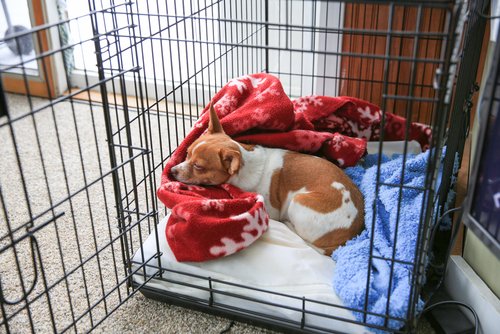Crate Training
Crate training is a valuable and effective tool for raising a happy, well-adjusted dog. While some may worry that crating a dog feels restrictive or harsh, when done properly, a crate becomes a secure and comforting space for your pet. Dogs are naturally den animals, and a crate mimics the cozy, safe environment of a den.
By introducing a crate to your dog's routine, you provide them with a designated place where they can relax and retreat when they need quiet time. It also helps establish healthy boundaries, supports house training efforts, and ensures their safety when unsupervised.
Below is a simple guide on how to crate train your dog.
Choose the Right Crate
Size: The crate should be large enough for your dog to stand, turn around, and lie down comfortably but not so big that they can use one end as a bathroom.
Type: Options include wire crates, plastic carriers, or fabric crates (for smaller dogs or travel).
First Create a Positive Association
Place the crate in a quiet, low-traffic area where your dog feels safe.
Make it cozy with a soft bed or blanket, preferably something familiar to the dog.
Leave the door open and let your dog explore the crate freely.
Toss in treats or toys to encourage your dog to go inside, however don’t close the door just yet.
Feed your dog their meals near or inside the crate to create positive associations.
Praise and reward your dog when they voluntarily go in.
Practice Short Stays
Once your dog is comfortable spending time in the crate with the door open, you can start closing the crate door for short periods while you’re nearby.
If you are using a Kong or other treat dispenser then this will be their reward for being in the crate, otherwise you can toss treats in there when they are being quiet and calm.
Gradually increase the time the door is closed, ensuring your dog stays relaxed. If they start showing signs of stress, then you are likely moving to fast through the steps.
Stay in sight initially, then practice leaving the room for brief moments.
When you let the dog out of the crate don’t make a fuss. Just open the door, give them a cue to let them know they can come out (like “OK”), then go about your day.
Extend Crate Time Slowly
Slowly build up to leaving your dog in the crate while you’re out of sight for longer periods, or even outside the house.
Always return before your dog becomes anxious or distressed. It may help to set up a camera on the dogs crate so you can monitor their stress levels while you are out of sight.
If your dog becomes too stressed, then you are likely moving to fast through the steps.
Use the Crate for Rest, Not Punishment
Never use the crate as a form of punishment.
Make it a calm, relaxing space where your dog feels safe and secure.
Don’t let anyone approach the crate while the dog is in there, especially kids. The dog should simply be ignored by everyone unless they are actively being trained, in which case the trainer would offer rewards to the dog when they are calm.
Using a crate cover can help make the crate feel extra cosy and safe.
Finally, Be Patient
Every dog adapts at their own pace. Some may take days, others weeks.
Stay calm and positive throughout the process. Crate training should be a calm and frankly quite boring exercise for everyone, which is a good thing!

